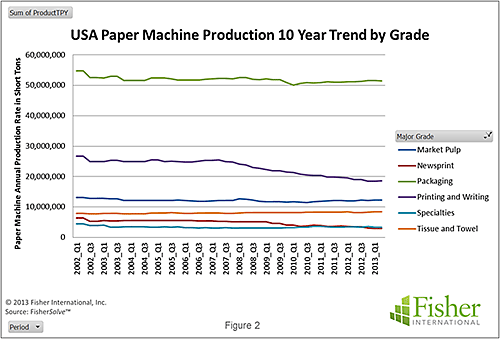 |
||||||||
| August 8, 2013 | ||||||||
| Smelt extraction shortens shutdowns and cuts costs |  |
|||||||
| · www.tappi.org · Subscribe to Ahead of the Curve · Newsletters · Ahead of the Curve archived issues · Contact the Editor |
Wisconsin and Paper, No Longer Synonymous Bill Burns Wisconsin news outlets have been highlighting results of a newly released ten year economic study commissioned by the Wisconsin Economic Development Corp. (WEDC). According to reports and the WEDC web site, pulp and paper manufacturing has dropped from first to third among Wisconsin businesses. (The full study is available from the WEDC "In Wisconsin" web site.) This study looks into some of the possible reasons why paper is becoming less significant in Wisconsin. At one time, Wisconsin was a top producer of pulp and paper in the United States. Today, Southern States like Georgia, Alabama and Louisiana have overtaken Wisconsin (Figure 1). The industry is shifting to wider and faster machines to feed the large 96 million ton U.S. paper demand. These new machine investments are being made in states with raw materials, proximity to population centers (the market), tax-friendly environment for business and individuals, and an amenable labor force. Wisconsin's machine base is becoming less competitive as expansions of new, more productive machines move into states like Georgia. Wisconsin now ranks 31st in production rate per inch of width where Georgia ranks 8th. The end result is a distinct cost disadvantage, with Wisconsin ranked 31st lowest in cost per ton compared to Georgia which is 14th. So, why is this? Wisconsin has the wood raw material base, but is at a disadvantage in other key drivers. Georgia is the largest producing state in 2013. A fact table on the WEDC web site shows that compared to Wisconsin, Georgia has lower corporate tax rates (6.0% versus 7.9%), lower personal income tax top bracket ($7,000 versus $232,640), a lower Unemployment Insurance Tax Rate (2.62% versus 3.6% for new employers), and Georgia prohibits union security agreements while Wisconsin protects them. Another key driver is population demographics. The population is shifting to southern states and their increasingly concentrated markets, leaving Wisconsin with a transportation disadvantage. Reduced reliance on printed media is another important dynamic impacting Wisconsin's paper industry. The digital age is taking its toll on paper use across the country. U.S. paper production demand in some key segments has been falling off for the last five years (Figure 2). Most notable are Newsprint and Printing and Writing grades. Some grades like Packaging are experiencing strong growth while consumer driven Tissue and Towel has steady growth tied to population. Wisconsin's problem becomes apparent when looking at the same 10-year trend for the state. Wisconsin is experiencing drop offs across all grades with the possible exception of Packaging (Figure 3). Losses in Printing and Writing is the most profound as smaller and older machines lose competitiveness in a shrinking market. Grades like Tissue and Towel and Specialties are growing slowly on a national base but trending down in Wisconsin. Even Packaging, which is experiencing solid growth nationally, is barely holding rates in Wisconsin. An improving economy nationally may help soften the blow to Wisconsin's paper business, but it will likely take a dramatic change in the state's business environment to stabilize or reverse the declining trend. Bill Burns is a Senior Consultant at Fisher International, Inc. and can be contacted at bburns@fisheri.com. The source for market data and analyses in this article is FisherSolve™, which describes the assets, capacity, and costs of every pulp and paper mill in the world making 50 TPD or more. To learn more, please visit www.fisheri.com.
Now that you
are Ahead of the Curve, stay there by joining TAPPI. |
|||||||
 |
||||||||






